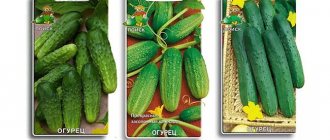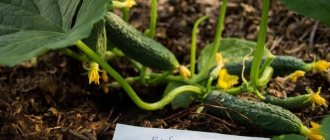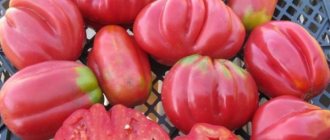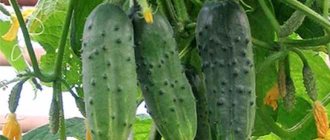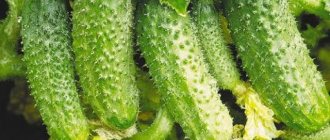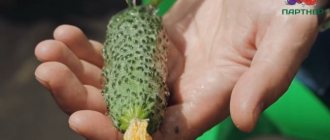General characteristics of the varieties Tescha and Zyatek
Cucumbers "Zyatek" and "Mother-in-law" are parthenocarpic hybrids. In terms of ripening time, they belong to early ripening varieties. The hybrid "Mother-in-Law" has a predominant female type of flowering. Both varieties produce good yields. Also, “Zyatek F1” and “Mother-in-law” are resistant to common cucumber diseases, as evidenced by numerous reviews from summer residents.
We have presented a general description of the varieties, and now a little more about each individually.
Description and characteristics of Mother-in-law cucumbers
- Cucumber Mother-in-law F1 is an early parthenocarpic hybrid.
- It is recommended to grow using film shelters, but you can also choose open ground.
- Parthenocarpic species do not require pollination by insects to produce fruits, which are often not sufficient in rainy summers even in open ground.
- According to vegetable growers, the Teshcha F1 variety is resistant to unfavorable weather, cold, high air temperatures, followed by heavy rains, as well as to fungal infection; it is rarely affected by powdery mildew, including downy mildew.
- The plant is highly productive, including due to the fact that the main vine is predisposed to unlimited growth.
- If the gardener does not need to get too large a harvest, the plant is pinched at the desired height. The side shoots of the hybrid also form fruits.
- From 3 to 4 ovaries develop in the axils of all leaves.
- From each bush you can collect on average from 5 to 6 kg of fruit.
Fruit characteristics:
- have approximately the same size, cylindrical shape, average length from 10 to 12 cm, and weight from 100 to 120 g;
- have thin, medium pubescent skin of a dark green color, on which short light blurry stripes are visible;
- the skin is covered with small brown, not too prickly tubercles;
- They are distinguished by tender, crispy, aromatic pulp without bitterness with small seeds, and have a good taste.
The fruits are formed evenly throughout the season, until frost sets in, which means that it is possible to obtain the above number of cucumbers from one plant not in several times, but in the entire growing season. Harvesting must be done daily or every other day.
It should be emphasized that the Teshcha F1 cucumber variety has the following advantages:
- excellent taste properties;
- early ripeness;
- high productivity;
- smooth fruit release;
- universal purpose;
- high resistance to disease and heat;
- increased cold resistance.
Features of the Tescha variety
Among modern hybrids, the Tesha variety is very popular. Moscow breeders created it more than 10 years ago.
Characteristics of the variety:
- fruit length – up to 13 centimeters;
- the weight of one cucumber reaches 130 grams;
- harvest from 1 bush - up to 6.5 kilograms.
The variety is classified as parthenocarpic, which means that Mother-in-law cucumbers do not need pollination.
Description and characteristics of cucumber Zyatek F1
The variety Zyatek F1 was selected by the Moscow Research Institute of Vegetable Growing of Protected Soil and Agro. In 2007, it was included in the State Register of Breeding Achievements of the Russian Federation. Cucumber is recommended for cultivation in the following regions of Russia:
- Severny;
- North-West;
- Central;
- Volgo-Vyatka;
- North Caucasus;
- Srednevolzhsky;
- Central black earth.
Son-in-law F1 is a hybrid form that has proven itself when grown under film shelters on private farms, as well as in open ground. But the seeds of such plants are not suitable for planting because they do not inherit the qualities of their parents.
Cucumber Zyatek F1 is an indeterminate plant with unlimited growth of the main stem, medium branching and a powerful root system. During the growing season, up to 50 bunches, consisting of 2–6 ovaries, can form on the main vine.
Cucumber Zyatek F1 is capable of forming several ovaries simultaneously in one node
Features of the Zyatek F1 hybrid
The hybrid was bred by Moscow breeders, along with the Mother-in-law hybrid. The seeds of these varieties are often mentioned at the same time; some manufacturers sell hybrid planting material in one package.
Characteristics of the variety:
- fruits grow up to 10-12 centimeters in length;
- weigh about 100 grams;
- Up to 7 kilograms of crop are harvested from 1 bush.
This is one of the favorite varieties of summer residents. It is valued for its compact size and high yield rates.
Features of the Tescha variety
Among modern hybrids, the Tesha variety is very popular. Moscow breeders created it more than 10 years ago.
Characteristics of the variety:
- fruit length – up to 13 centimeters;
- the weight of one cucumber reaches 130 grams;
- harvest from 1 bush - up to 6.5 kilograms.
The variety is classified as parthenocarpic, which means that Mother-in-law cucumbers do not need pollination.
Similarities between the cucumber varieties Tescha and Zyatek
First, let's look at the similarities:
- Both of these varieties are hybrid and early ripening.
- They are not bitter at all, even when they are overripe.
- They grow well both in greenhouses and in open ground.
- Practically do not require pollination by insects.
- The productivity is quite high.
- The first harvest can be harvested in just fifty days.
- Perfect for salads, pickling and marinade.
- They have fairly good resistance to powdery mildew.
Reviews from gardeners about Zyatek F1 cucumbers
The hybrid of the described variety is one of the most popular among gardeners, because it provides a high yield with a minimum of labor. Son-in-law F1 will delight you with its delicious greens until the fall, and in the winter it will allow you to enjoy crunchy and refreshing salted and pickled cucumbers.
- Author: Lyudmila Bartasevich
My name is Ludmila. Higher education, graduated from the Minsk Institute of Culture. I live in Belarus. Rate this article: (4 votes, average: 5 out of 5)
Differences between Mother-in-law and Son-in-law
- The mother-in-law has a larger fruit size (about thirteen centimeters, while the Zyatek cucumber has only ten).
- The weight of one Mother-in-law cucumber reaches one hundred and twenty grams, the Zyatek cucumber is slightly less - one hundred grams.
- The Mother-in-law’s skin is pimply with dark thorns, while the Son-in-law’s has white ones.
- Mother-in-law cucumbers are resistant to root rot, and Zyatek cucumbers are resistant to mosaic virus.
- Mother-in-law’s yield from one bush is up to seven kilograms per bush, and Zyatek’s is seven and a half.
How does Zyatek differ from Mother-in-law?
This variety of cucumbers has many similarities with Mother-in-law, but there are also distinctive features. So the size of the fruit is no more than 11 cm, and the weight does not exceed 110 g. The skin is also green, but with light stripes. The taste is the same as that of Mother-in-law.
Important! The Teshcha and Zyatek varieties, with proper care, can produce up to 12 kg of cucumbers from 1 “square”.
The hybrid variety is suitable for cultivation throughout our country. Its popularity is justified by the following advantages:
- Excellent taste;
- Universal scope of application;
- Possibility of early harvesting for gherkins and pickles;
- Good transportability of fruits;
- Marketable type of fruit;
- High yields;
- Good adaptation to adverse weather conditions;
- High germination rates of planting material;
- Easy to care for;
- Good immunity against many diseases.
The only drawback of this variety is the high cost of planting material.
Reviews
Olga, 51 years old, Lakinsk
I have been growing the Zyatek variety of cucumbers for a long time. It has excellent germination and amazing taste. In addition, it is incredibly productive, I even had to give it away. Every year we collect cucumbers every three days for more than two months. Son-in-law's lashes do not dry until the end of August. Each of them contains a lot of fruits. Cucumbers taste great! With thin skin and sweet flesh. Due to their density, which they do not lose, they are excellent for pickling. They turn out crispy and strong. I highly recommend this variety.
Maria, 49 years old, Kovrov
This year I chose Mother-in-law and Zyatek cucumbers for planting - the reviews about them were amazing. And now I understand why. They are incredibly productive. I didn’t prepare the seedlings; I planted slightly germinated seeds. These varieties of cucumbers are self-pollinating, so the ovaries form very quickly. Cucumbers of the Teshcha and Zyatek varieties are very similar. I dropped them off nearby and then I didn’t even understand which was which. It is better to pick cucumbers when their size is about 10 cm. If this is not done, the fruits become rounded and grow to a decent size. As the manufacturer promises, there is really no bitterness in cucumbers. I really liked that we picked cucumbers before the beginning of September. I consider the only drawback of these varieties of cucumbers to be their cost - it is a bit high. Otherwise, the Teshcha and Zyatek varieties are excellent! I will plant it myself and recommend it to others.
Resistance of varieties Tescha and Zyatek
Cucumbers “mother-in-law” and “son-in-law” are quite disease-resistant. However, plants can still get sick, especially often if they are not cared for properly. What problems can arise when growing cucumbers?
- The plant is covered with a layer of gray rot. Stems and leaves become slimy. It is advisable to wipe the plant with a bunch of grass and get rid of rot. You can cure the bush using a special solution of chalk, water and potassium permanganate. This mixture wipes the entire bush from stems to leaves.
- The appearance of yellow-brown spots on the leaves. If the bush turns yellow, most likely the plant is affected by a fungal disease. Another sign is the appearance of watery spots on the fruits themselves. To defeat the fungus, you need to immediately get rid of the damaged areas of the plant and ventilate the greenhouse more often.
- The appearance of a gray-olive coating and multifaceted uneven spots on the leaves. This disease is called "peronosporosis". It occurs due to excess moisture. Sometimes downy mildew appears during summer cold spells, which can last for more than one day. To combat this disease, the leaves are sprayed with whey.
Advantages and disadvantages
Descriptions of cucumbers Zyatek F1 and Mother-in-law F1 highlight their advantages and disadvantages.
Among the advantages of varieties are:
- ability to grow in a greenhouse and in open ground;
- do not require pollination;
- the period from planting to harvest is approximately 45 days;
- high yield rates;
- show resistance to infections common among vegetable crops;
- The fruits are small in size, suitable for fresh consumption, suitable for pickling and pickling.
Among the disadvantages, gardeners cite the increased cost of the material and the need to comply with some special conditions when growing.
Planting cucumbers Mother-in-law and Zyatek
A similar planting pattern is what unites the “mother-in-law” and “son-in-law” cucumbers. Reviews and photos can be seen in this article. Most often, plants are planted at a distance of at least 50 cm from each other. What does every gardener need to know who decides to grow “mother-in-law” and “son-in-law” cucumbers?
- To get seedlings on time, seeds are planted in early April.
- The appearance of several leaves on the shoot is a sign that the plant can be planted in a greenhouse or open ground. Most often this period falls at the end of May.
- The land for planting must be prepared in advance.
Pre-sowing seed treatment
Planting material for growing seedlings is purchased in advance. The varieties Zyatek and Tescha are classified as early ripening, so sowing of seeds is carried out no earlier than the beginning or mid-April.
Before sowing, the seeds go through:
- calibration;
- disinfection;
- soak.
It is recommended to germinate the seed material of these varieties before planting. To do this, the material is placed on a flat surface covered with a damp cloth, covered with a second layer and left in a warm place. These procedures increase germination rates.
Sowing seedlings
Seeds are placed in separate containers. To do this, choose between plastic cassettes or peat pots. Cucumbers are not planted in common containers because the crop does not tolerate picking.
For seedlings, it is necessary to select a drainage layer and soil mixture suitable for vegetable crops. The seeds are buried 1.5 centimeters, then moistened with a spray bottle. The seedlings are placed in a warm place until shoots appear. The emerging leaves need at least 12 hours of daylight. Cloudy weather for several days can slow down the growth of seedlings.
Planting outside is carried out when 3 or 4 leaves appear, as well as taking into account weather conditions. The soil for planting must be completely warm.
Gardeners have set the minimum temperature limit for the soil for planting cucumbers, it is +15 degrees.
Seedling care
During the day the temperature is in the range of 20-25°, at night it can drop to 15-19°. The humidity in the room should reach 60-70%. Usually, a container of water is placed next to the boxes with seedlings. It should be remembered that this hybrid variety of cucumbers needs a lot of light.
How to care for cucumbers Zyatek and Mother-in-law
To grow cucumber varieties, they use agricultural techniques available to any gardener. Productivity depends on compliance with basic rules related to the characteristics of hybrids.
Feeding and watering
After planting, cucumbers require regular watering. Frequency and volume depend on weather conditions. The varieties can survive periods of drought when the vines are fully formed. But for the growth phases and active formation of the ovary, plants do not need stress.
During active flowering, experienced gardeners advise reducing irrigation volumes; this is necessary in order not to delay fruiting. The type of irrigation used to water cucumbers is drip or subroot. Rain irrigation is completely excluded for these varieties.
Information! Watering cucumbers is especially effective in the early morning or late evening.
To fertilize these varieties of cucumbers, mineral fertilizers are chosen and watering is carried out at the root. Throughout the season, 3 to 5 procedures are performed, most often during flowering and fruit set. Types of fertilizer:
- complexes with potassium and phosphorus;
- organic mixtures (from manure, bird droppings);
- wood ash and nitrogen-containing complexes during planting.
Loosening and weeding
Loosening of the soil is carried out until the central vine grows. After root feeding, the soil is loosened, regardless of the condition of the bush.
Weed control is essential for root development and growth. Weeds around the main fence are removed as they appear.
Garter
The stems of the plant, especially when grown indoors, must be tied up. The best support is trellises, which it is advisable to install before planting the cucumbers in the ground. They should have a height of 1.5 to 2 meters. If twine is used for tying, it must be secured with a loop on the cucumber lash at a height of about 10–15 cm from the ground.
Do not allow strong tension on the twine or excessive tightening of the loop, as this can damage the plant stem and crush it.
Hilling and pinching
Cucumbers of the Tescha and Zyatek varieties have a similar feature: the main stem is capable of unlimited development. This feature ensures high yield rates. To control this property, pinching the main lash is carried out.
They begin to pinch the main stem at a height of at least 2 meters. Pinch the side whiskers as needed.
For these varieties, it is recommended to use a tying system and install additional supports. Tall stems will do well when positioned above the ground. Hilling up for cucumber means the formation of a strong root system. It is carried out after the formation of 2 or 3 knees.
Formation of the lash
Experienced gardeners strongly recommend that when growing cucumbers, pay attention to a particularly important agrotechnical technique - the formation of a plant bush. Son-in-law and Mother-in-law are hybrids with bunched ovary formation, so it is better to grow them in one stem. The formation of such a lash is carried out according to the following scheme:
- The main lash is tied to the trellis as soon as 4–5 true leaves form on it.
The garter loop is placed under the 1st or 2nd leaf without tension, as the cucumber vine sometimes pulls upward with such force that it pulls out of the ground - The three lower nodes of the plant are blinded, that is, flowers and emerging side shoots are removed.
- At a distance of 1 m from the surface, side shoots up to 20 cm long are left, pinching off their tops.
The tip of the shoot (growth point) is carefully broken off or trimmed with scissors - At a height of 1 m to the end of the trellis, side shoots about half a meter long are left, on which there will be at least 3 leaves and 3 bunches of ovaries.
- When the lash grows to the height of the trellis, it is secured and the top is pinched.
When forming a lash, securely fix the cucumber stem along its entire length so that it does not break under the weight of the fruit.
Some gardeners do not pinch the main vine at the top of the trellis, but let it hang freely and remove the growing point only when the stem reaches the ground.
As a result, the cucumber lash should resemble an inverted isosceles triangle. At the bottom, the plant is well ventilated, which means it is less susceptible to diseases, and the load on the main stem increases gradually.
Recommendations for cultivation
Cucumber varieties Mother-in-law and Zyatek can be grown either through seedlings or by planting seeds directly into the garden bed. In this case, the speed of appearance of the first shoots directly depends on the temperature:
- at temperatures below +13 degrees the seeds will not germinate;
- at temperatures from +15 to +20, seedlings will appear no later than 10 days;
- If you provide a temperature of +25 degrees, then seedlings may appear as early as day 5.
Advice! It is better to choose the “golden mean” and provide the seeds with a temperature of up to +20 degrees. Such shoots will not only be early, but also hardened.
The seeds of these varieties are sown in a greenhouse or in open ground at the end of May in holes up to 2 cm deep.
When growing through seedlings, its preparation should begin in April. At the end of May, the finished seedlings can be planted either in a greenhouse or in a garden bed. The main indicator of the readiness of cucumber seedlings is the first few leaves on the plant.
At the same time, it is recommended to plant seeds or young cucumber plants every 50 cm. Planting closer will not allow the bushes to develop to their full potential, which will negatively affect the harvest.
Further plant care includes:
- Regular watering, which should be carried out until the fruits ripen. At the same time, watering should be done moderately. Excessive watering will lead to rotting of the root system of the bushes.
- Weeding and loosening.
These are not mandatory procedures, but recommended. The Teshcha and Zyatek varieties will not leave them unattended and will respond with a good harvest. Advice! Loosening the soil should be done no more than once a week and very carefully so as not to harm the plant. - Feeding.
It is especially important during the growing season of the plant. It is best to fertilize once a week, combining it with evening watering. Good results are obtained by using solutions of potassium and phosphorus. But experienced gardeners prefer to use diluted manure. Important! Excessive application of fertilizers can ruin the plant.
During the period of active growth, you can tie up young cucumber plants. This will not only give the bushes a direction to grow, but will also allow them to receive more light.
Mother-in-law and Zyatek begin harvesting cucumbers in early July as the fruits ripen.
Harvesting
The fruits are harvested in mid-summer, usually when planted in open ground using seeds or seedlings. The frequency of collections is 2 days. If you do not free the vines from ripened fruits in time, you can slow down the development of new ovaries.
A feature of the varieties is the absence of signs of overgrowth. Experienced summer residents have determined that cucumbers of this variety do not increase in size during prolonged growth, but curl inward and become hook-shaped.
Before pickling, the fruits are soaked in cold water to preserve their beneficial qualities and taste.
Diseases and pests
The advantage of the varieties is their resistance to diseases such as powdery mildew. The danger lies in fungal infections that can affect the crop due to a sharp change in temperature or violations of irrigation rules.
Downy mildew can affect cucumber varieties due to oversaturation with moisture. It is characterized by the appearance of brown spots on stems, leaf blades or fruits. The affected parts of the lashes are removed, the rest are sprayed with special solutions. The main option is urea solutions. Among folk methods, spraying with a milk solution is popular.
In summer, cucumbers are attacked by aphids, thrips, slugs and other insects. To get rid of them, popular insecticides are used. Preventive spraying is considered the best measure to combat parasites.
melon aphid
The melon aphid settles in large colonies on the reverse sides of leaf blades, bites through young leaves and shoots, and drinks the juice from them. As a result, the plant begins to wither, weaken, and dry out. Associated pests are ants, which protect aphid colonies and provide conditions for their active reproduction. Therefore, it is necessary to fight both aphids and ants.
If the pest is detected in a timely manner, it will be enough to treat the plantings with the indicated infusions, adding laundry soap to their composition. It contains caproic acid, a weakly concentrated solution of which can destroy up to 90% of aphids. In addition, soap will ensure that the insect sticks to the leaf, and substances with a more aggressive toxic composition already complete the procedure, completely destroying the pest.
Recipe for a soap and soda solution to kill aphids:
- Take 1 tbsp. a heaping spoon of baking soda and 1/4 of a standard piece of laundry soap, grated on a coarse grater.
- Mix the substances, pour in 1 liter of boiling water, stir again.
- Dilute the concentrate with 10 liters of water.
- Spray the plants with the resulting mixture.
The melon aphid is a small insect with a body length of up to 2 mm and various colors: from yellow to black
It is recommended to plant onions, garlic, marigolds, and borage next to cucumber plantings. The smell of these plants repels the pest.
Spider mite
The pest feeds on plant sap, weakening leaves and stems. Damaged green parts of borage are best removed. A more radical measure in the fight against spider mites is to treat the plantings with biological preparations Fitoverm or Bitoxibacillin (according to the instructions).
Spider mites feed on the cell sap of plants, especially often affecting plantings in greenhouses and hotbeds

